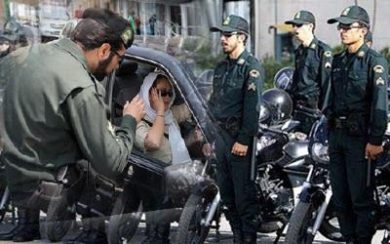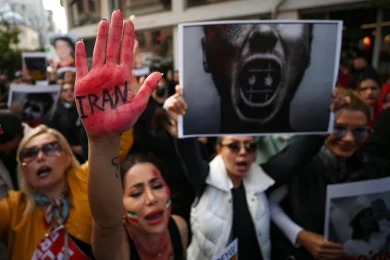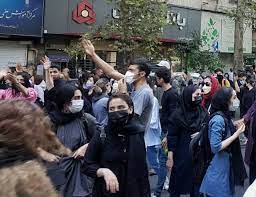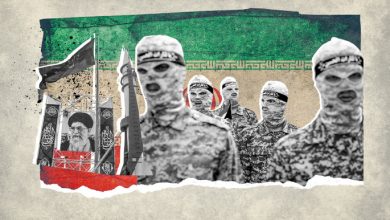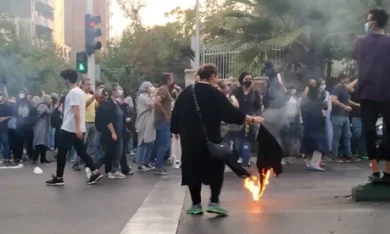When the world heard the name Mahsa Amini in 2022, a spark ignited—not just in the streets of Tehran and Sanandaj, but across capitals like Paris, London, New York, and Sydney. Women everywhere recognized themselves in her story: a young woman detained and killed for how she wore her hijab. Her death resonated far beyond Iran’s borders, inspiring a global sisterhood that refuses to be silent.
From protests and petitions to performances and policy demands, women around the world are showing that Iranian women’s fight is a global cause. This sisterhood is more than symbolic—it is political, cultural, and deeply human. The movement is about more than solidarity; it’s about shared resistance against patriarchal repression and authoritarian control, wherever it may exist.
1. From Iran to the World: The Ripple Effect
A. “Women, Life, Freedom” Becomes a Global Slogan
Originating from Kurdish feminist movements and now echoed by Iranian protesters, the chant “Jin, Jiyan, Azadi” (“Women, Life, Freedom”) became the anthem of a worldwide movement. This slogan, simple yet profound, has been seen on placards in Times Square, chanted in Berlin, and projected onto buildings in Paris.
In every country, the message is clear: the struggle of Iranian women is the struggle of all women who resist misogyny, state violence, and authoritarian rule.
B. Protests in Solidarity
Mass rallies in over 150 cities worldwide—organized by Iranian diaspora groups, feminist networks, and human rights organizations—have created unprecedented visibility for Iran’s protest movement.
Notable actions include:
• A 50,000-person march in Berlin (October 2022), one of the largest protests in German history led by exiled Iranian women.
• Massive human chains in Toronto, Melbourne, and Oslo organized by grassroots collectives demanding international action.
• Flash mobs and silent protests in Afghanistan, India, and South Korea, where women faced their own risks in expressing solidarity.
2. Art, Music, and Cultural Resistance
A. Global Artists Amplify the Message
Artists like Shirin Neshat, Shohreh Aghdashloo, and musicians such as Sevdaliza and Roya have used their platforms to amplify the voices of Iranian women.
International campaigns like “Hair for Freedom”, where women cut their hair in solidarity, went viral on platforms like Instagram and TikTok. These artistic gestures transcend language and borders, communicating solidarity through powerful imagery.
B. Cultural Institutions Join the Movement
• The Venice Biennale, Berlin Film Festival, and Sundance have dedicated special segments to Iranian women filmmakers and political art.
• Museums like The Tate Modern and LACMA have hosted exhibitions themed around Iranian resistance and female power.
These spaces help preserve the narratives the regime attempts to erase, creating cultural memory and momentum for the movement.
3. Feminist Alliances in Action
A. Intersectional Feminism on Display
Women from diverse backgrounds—Palestinian, Kurdish, Black, Latina, and Indigenous—have emphasized that the struggle in Iran reflects global issues like:
• State control over women’s bodies
• Censorship of female voices
• Gender-based violence and impunity
This intersectional support has led to coalition-building across movements, ensuring that the Iranian cause remains a feminist priority globally.
B. Sisterhood in the Global South
Solidarity has also taken root in unexpected places:
• Afghan women’s groups risking arrest to protest in Kabul and Herat.
• Pakistani feminists dedicating Aurat March slogans to Iranian women.
• Nigerian activists drawing parallels between #EndSARS and the Iranian regime’s brutality.
These alliances defy geopolitical divisions, reminding the world that solidarity is not a privilege—it’s a responsibility.
4. Digital Resistance Across Borders
A. Diaspora’s Role in Keeping the Story Alive
Women in the Iranian diaspora—journalists, influencers, and digital activists—have been instrumental in sustaining international attention. Figures like:
• Masih Alinejad, whose platform reaches millions, continues to expose IRGC abuses.
• Hoda Katebi and Negar Mortazavi, amplifying grassroots voices and providing context in international media.
With internet shutdowns in Iran, these global voices have become the lifeline of truth.
B. Online Campaigns as a Tool of Pressure
Global campaigns like:
• #MahsaAmini
• #WomenLifeFreedom
• #FreeIran
have not only trended globally but have also forced politicians, celebrities, and organizations to take a stance.
5. Political Pressure and Policy Advocacy
A. Calls to Designate the IRGC as a Terrorist Organization
One of the major demands of the global sisterhood is for international governments to:
• Sanction the IRGC for human rights violations.
• Expel IRGC-linked figures from Western countries.
• Investigate financial networks connected to repression.
Several parliaments, including Canada’s, Germany’s, and Sweden’s, have debated or passed motions echoing these demands—spurred in part by feminist advocacy.
B. Asylum and Protection for Activists
Global women’s organizations have also lobbied for:
• Fast-track asylum for fleeing Iranian activists.
• Legal aid for those imprisoned or exiled.
• UN recognition of gender apartheid as a human rights violation.
The support is not only symbolic—it’s saving lives.
6. Men Joining the Movement Through Feminist Lens
The global sisterhood also includes male allies:
• Iranian men cutting their hair in solidarity.
• Diaspora brothers and sons organizing protests alongside women.
• Prominent male artists, musicians, and athletes speaking up against the regime.
This is not a women-only issue—it’s a human issue.
7. Challenges in Sustaining Global Solidarity
While the initial wave of outrage was massive, maintaining momentum is an ongoing challenge. The Iranian regime counts on the world’s attention span to shrink. Activists warn against:
• Performative activism (e.g., symbolic gestures without action)
• Media fatigue
• Silencing of Iranian voices in international forums
The sisterhood must evolve from visibility to action, from hashtags to policy changes.
8. What’s Next: From Solidarity to Structural Change
To truly support Iranian women, global efforts must include:
• Institutional support for Iranian civil society and women’s organizations.
• Ongoing education through media, schools, and cultural platforms.
• Funding independent journalism and tech access for women inside Iran.
Conclusion: A Sisterhood That Knows No Borders
The global sisterhood for Iran is more than a moment—it’s a movement. It proves that women’s freedom anywhere is tied to women’s freedom everywhere.
From Tehran to Toronto, from Kabul to California, this sisterhood is rewriting what international solidarity looks like. It’s loud, creative, strategic, and above all, unapologetically feminist.
Join Our Newsletter!
Stay informed with the latest updates, news, and ways to take action in the fight for justice and global security. Sign up now to get updates delivered straight to your inbox!

